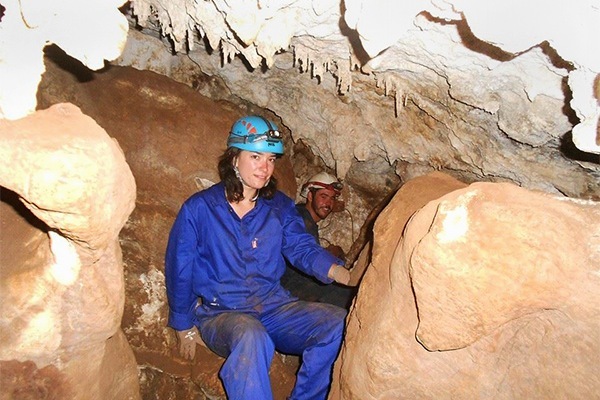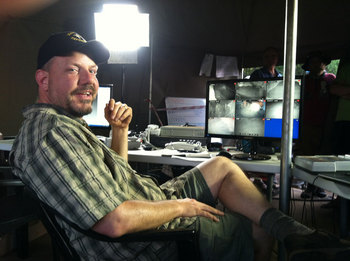Anthropologist, ‘underground astronaut’ strike fossil gold in South Africa dig

Alia Gurtov was part of a team of archaeologists chosen for their small size and high skills to retrieve a trove of fossilized bones from a tight space in a South African cave.
Photo: Allen Herwig
Squeezing through a gap called the International Postbox and climbing the jagged Dragon’s Back were not in Alia Gurtov’s plans for the fall semester, but she made an exception in order to participate in a wildly successful archaeological expedition into a South African cave.
Over the last three weeks, Gurtov, a UW–Madison graduate student, and five other spelunking scientists have hauled hundreds of fossilized bones — likely the remains of several distant relatives of humans — through a rock crevice barely 18 centimeters wide.
“Every time I stop to think about what I’m involved in, I am almost overwhelmed by my incredibly great fortune,” she said via email during a break. “Luckily, there are so many details to attend to in my daily life that I can maintain a reasonable level of excitement.”
Gurtov and nearly 60 other people who were both relatively small and inordinately skilled archaeologists and excavators answered a plea sent over Facebook, Twitter and LinkedIn in October from Lee Berger, a professor of human evolution at the University of the Witwatersrand in Johannesburg and a National Geographic Society explorer in residence.

John Hawks at the archaeological site’s Command Center, keeping an eye on the scientists 30 meters below.
Photo: Andrew Howley/National Geographic
Berger, leader of National Geographic’s Rising Star Expedition, tapped six women he has called “underground astronauts” to recover remains from a cavern 30 meters underground at the Cradle of Humankind, a World Heritage Site in northeastern South Africa. The cradle is the site of some of the oldest hominin (human relatives closer on the family tree than gorillas or chimpanzees) discoveries ever, reaching back more than 3 million years.
UW-Madison anthropologist John Hawks joined the expedition, lending his expertise in human evolution in the “science tent,” where fossils are studied as they emerge from the cave.
While it may be many months before the researchers determine the species of the individuals — and there are more than a dozen individuals represented in the fossil haul — the sheer volume of bones makes it far more likely that analysis will reveal meaningful things about their lives.
“The most important thing is that relatively complete skeletal remains allow us to understand how different features are connected to each other in evolution. In many fossil sites we have only fragments of a single skeletal part, like a leg bone, or part of a skull,” Hawks said via email, after the cavers had unearthed everything from cranium and mandible pieces to toe bones. “We will not have absolutely complete skeletons here, but we will have much more of the anatomy represented. And we can understand how the pieces from other sites may be connected to each other.”
While it may be many months before the researchers determine the species of the individuals, the sheer volume of bones makes it far more likely that analysis will reveal meaningful things about their lives.
The fossil deposits have not yet been dated, but calcite deposits created as the cave formed may help determine the fossils’ age, Hawks has written in National Geographic’s blog coverage.
The largest challenge for Gurtov and the cavers was safely recovering and carefully preserving fragile bones sapped of their calcium over millennia. As the fossil count ballooned into the hundreds — eventually, more than 1,000 were collected — Berger had to step away from the expedition’s encampment to find a new stock of plastic containers for storage.
Deep in the ground, three-caver shifts worked alongside cameras serving as eyes for Berger and Hawks and with special lighting equipment to free fossils from sediment exactly as they would in an exposed, ground-level dig.
Still, the process was unique even to Gurtov, who has extensive excavation experience at sites in Canada, Georgia, Germany, Tanzania and South Africa.
“The delicate fossil bone goes into a small plastic bag, a second plastic bag with ID tags, then into a plastic container lined with bubble wrap, and placed in a watertight bag with more bubble wrap,” Gurtov said. “The bag is attached to a carabiner, and hoisted up the chute. If one of us is ready to ascend, we follow the bag up and then carry it carefully down Dragon’s Back and out into the world. We are met at the cave entrance by one of the head scientists, who gleefully carries the bag away to the science tent.”
The tricky spelunking and enormous fossil count are not the only unusual aspects of the Rising Star Expedition. The dig also played out in daily videos and blog posts on the National Geographic website, and on Twitter with live coverage from participants like Hawks (@johnhawks) and Gurtov (@agurtov).
For Hawks, an outspoken advocate for open access to research, the revealing approach of Rising Star (@RisingStarExped) is pure Wisconsin Idea.
“Here we are working with an African research team, an African university, getting things out to the international public as they happen,” he said. “We are relying on the cooperation and help of local cavers and the local community, and the six advance scientists recruited from around the world. We owe it to everyone to make this as open a process as possible.”
Tags: anthropology, archaeology, evolution, international, research




